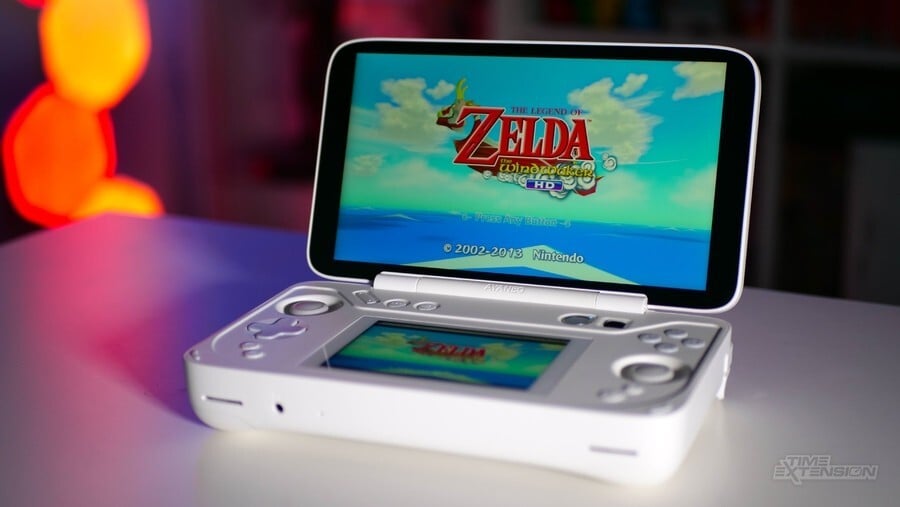
When we reviewed the AYANEO Flip KB not so long ago, we found it to be an interesting device with some unique strengths and weaknesses, but we also commented that the more intriguing of the Flip pair was the Flip DS, which has a second screen, just like the DS and 3DS.
Now that we've had the chance to spend a bit of time with this device, we can confirm this idle suspicion to be accurate; this is one of the most interesting handheld gaming PCs we've had the pleasure of using, and a lot of it is predictably down to that second display.
However, is it worth the steep asking price? Let's find out...
AYANEO Flip KB Review: Design & Displays
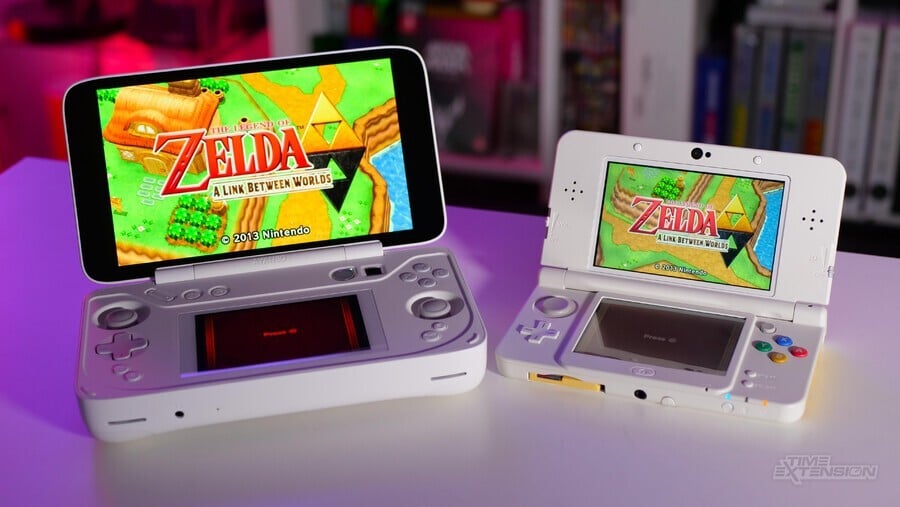
The Flip DS (which starts at $739 if you take advantage of 'early bird' crowdfunding pricing) and Flip KB are essentially the same device; when closed, both of these clamshell products look identical. It's only when you open them up that the key difference becomes immediately apparent – while the KB has a full QWERTY keyboard on the lower section, the DS has a second 3.5-inch, 960x640 pixel touchscreen (the unit's main screen is a 7-inch 1080p IPS panel with a 120Hz refresh rate, in case you were wondering).
Much of what was said in the Flip KB review regarding power, battery life and general ergonomics applies to the Flip DS, too. In short, the Ryzen 7 chipset has processing grunt to spare, battery life is poor, and we're still not totally sold on recessed analogue sticks and pancake-flat D-pad – but we're going to focus the bulk of this review on the possibilities that the second screen delivers; it's fair to say we came away pleasantly surprised.
First up, some ground rules; the Flip DS' second screen is treated like an external monitor by the Windows 11 OS the unit is running on. By default, it displays a unique set of options and information related directly to AYANEO's AYASpace application. From here, you can see data such as the current TDP (thermal design power) of the Ryzen 7 chipset (the unit we were sent has a 7840U inside, but an 8840U model is also available), the RPM of the internal fan and even the remaining battery life, download/upload totals and the amount of RAM currently being used.
A 'Performance' screen can be accessed by swiping to the right, and this allows you to instantly toggle things such as the TDP, FPS limit and other settings. On AYANEO's other device, all of this is traditionally done by pressing the AYANEO button and using the pop-in menu, but on the Flip DS, having a second screen makes things a lot more elegant.
A 'Quick Assistant' screen is found to the right of the 'Performance', granting access to various quick settings for WiFi, screen lock, on-screen keyboard and the like, while next to this is a customisable 'Applications' panel, where you can add your favourite apps and launch them directly from the second screen – a small but surprisingly welcome feature. Finally, we have perhaps the most interesting screen, which is called 'Smart dual-screen'. From here, the AYASpace software tells you what content can be displayed on the second screen and makes the process pretty effortless (a physical button can be used to toggle between content on the bottom display, too).
To give an example, when we launched the 3DS emulator Citra, both the top and bottom 3DS screens automatically appeared on the Flip DS' upper display – just as you'd expect if you were using a traditional desktop PC. By navigating to the 'Smart dual-screen' options on the Flip DS' second screen, we were able to find Citra's lower 3DS display window and quickly assign it to the lower of the device's displays – recreating the setup seen on Nintendo's handheld.
It's not an exact science, and there were times when we found it tricky to get the right window to display in the correct screen, but once you've gotten your head around things, it soon becomes more natural.
AYANEO Flip KB Review: Specs & Pricing
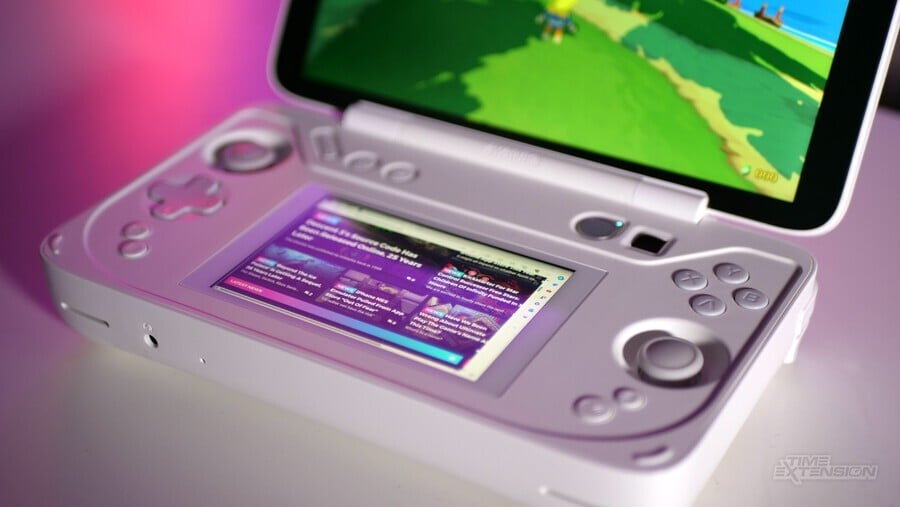
| CPU | AMD Ryzen 7 7840U / 8840U |
| Main Display | 7-inch 1080p IPS Dynamic Screen (120Hz) |
| Secondary Display | 3.5-inch 960x640 IPS Touchscreen |
| Storage / RAM / Price Options |
|
| RAM Type | LPDDR5X |
| Max TDP | 28W |
| Battery | 45W |
| Wireless Connectivity |
|
| Control Interface |
|
| Vibration | X-axis Linear Motor |
| Motion Controls | 6-axis Gyroscope |
| I/O Options |
|
| Audio Output | 3.5mm Headphone Jack |
| Biometrics | Fingerprint Scanner |
| OS | Windows 11 64-bit Home Edition |
AYANEO Flip KB Review: DS, 3DS & Wii U Emulation

What you're effectively getting here is a handheld which can reproduce the experience of using a DS or 3DS (almost) perfectly; for the former, it requires a bit of extra work to get the content across both screens as the currently available DS emulators don't support dual-screens, so you'll need to 'stretch' the image across the Flip DS' two displays.
In the case of the latter, Citra allows you to split the screens in separate windows without any issue, but you naturally lose the autostereoscopic effect. On the upside, you can run 3DS software at 1080p, which makes titles like Zelda: A Link Between Worlds and Metroid: Samus Returns look utterly fantastic.
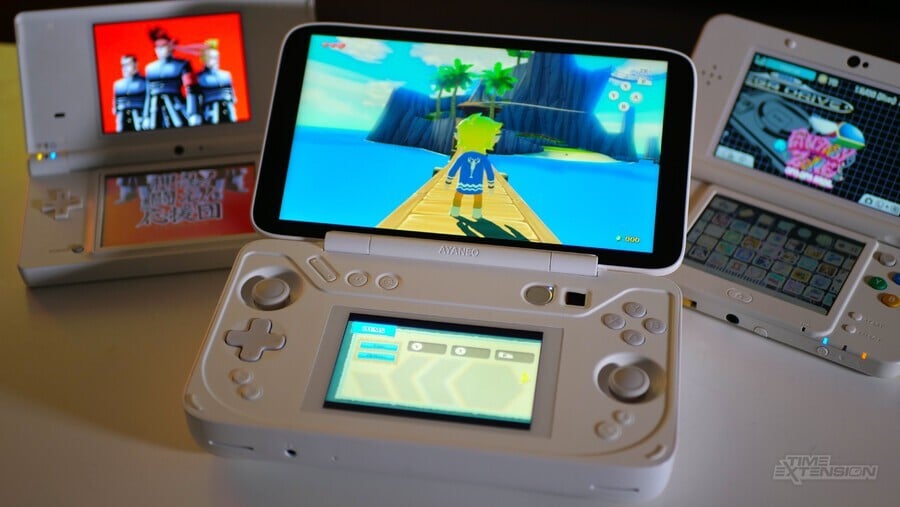
A caveat worth mentioning is that the capacitive touch panel on the Flip DS naturally won't work with a DS/3DS stylus, as those were designed with more primitive resistive displays in mind. This isn't an issue when you're merely selecting options or fiddling with your inventory on the lower display, but games like Meteos or Zelda: Spirit Tracks are awkward to play. Investing in an 'active' stylus alleviates this issue a little, but these rarely offer the same kind of precision.
Another big bonus here is the ability to play Wii U games via this dual-screen setup. Sure, we all know that developers (Nintendo included) failed to use the console's GamePad screen to its fullest potential, but there are situations where the Flip DS actually improves certain Wii U games. Take Star Fox Zero, for example; at the time of release, it was criticised for its unorthodox control scheme, which required the player to constantly switch their view from the main TV to the GamePad, which was used for precise aiming. Having the two screens one on top of the other – as is the case with the Flip DS – makes this configuration a lot easier to stomach.

There are some quirks that need addressing before you can fully enjoy your DS, 3DS and Wii U games on the Flip DS. The bottom display will always show the Windows bar at the top, so you'll need to install a third-party application called Borderless Gaming to remove that (thanks to Retro Game Corps for the tip). This also allows you to suppress the mouse pointer, which sometimes appears on-screen as you move the analogue sticks around and is quite distracting.
You'll also need to resort to a third-party app to get motion controls working; we spent quite some time trying and failing to get AYASpace's built-in motion controls to work on Wii U and 3DS before finding that Handheld Companion was the solution (again, huge thanks to Retro Game Corps for pointing us in the right direction here).
Another problem is that AYANEO's chosen button layout isn't the same as Nintendo's, so you'll often find that a prompt to 'press A', in fact, means you need to press the Flip DS' B button. This isn't a big problem, in all honesty, but we thought it was worth highlighting.
AYANEO Flip KB Review: Performance
Moving away from Nintendo's dual-screen consoles for a moment, it's worth stressing that, just like the Flip KB and many of AYANEO's other Steam Deck rivals, the Flip DS has enough power under its hood to emulate pretty much everything up to and including the PS3 and Xbox 360 – not to mention modern-day titles downloaded from Steam, such as Baldur's Gate 3 and Helldivers 2.
Because it's running more powerful internal hardware than the Steam Deck, performance is much better than it is on Valve's handheld, with one caveat – Windows 11 simply wasn't built with touchscreens in mind, and navigating the UI is often an exercise in frustration (this is something we've mentioned in all of our handheld gaming PC reviews, to be fair).
The ability to adjust the amount of power the device is consuming means you can pick the right TDP setting for the content you're playing, but taking things all the way up to the maximum setting of 28W gives you a lot of processing grunt – although it goes without saying that this will destroy your battery life; you'll be lucky to even get an hour of use running the device at full pelt. Dropping the TDP down to around 6W will still allow you to run quite a lot of content, but even then, you're looking at around two hours. Stamina is not a strong point of these kind of devices. It's also worth saying that the internal fan gets pretty noisy when the device is running at full speed.
Returning to the second screen, its usefulness is not limited solely to replicating the dual-display experience you'd get on a Nintendo console. You can use that lower display for literally anything, so you could be playing a GBA title on the main display whilst browsing a walkthrough guide (either on a website or via YouTube) on the bottom one. Or you could mix two entirely different functions at once; you could be playing a retro game on the lower screen (when resolution isn't so much of an issue) and watching the latest episode of Fallout on the main HD display.
The Flip DS includes an OCuLink port, which means you can dock the system and treat it like a desktop PC, complete with the ability to bolster its power via a dedicated graphics card.
AYANEO Flip KB Review: Conclusion
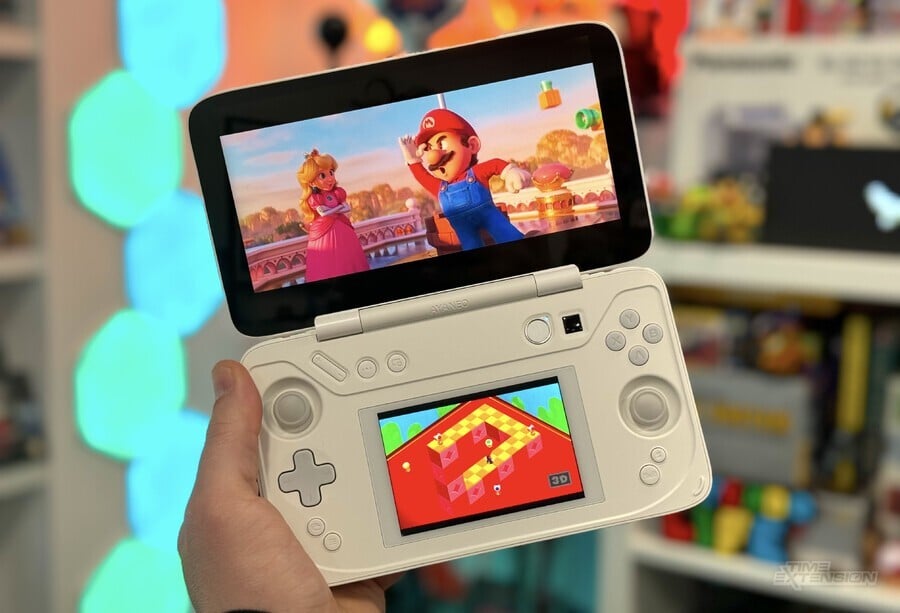
We have to admit, we were pleasantly surprised by how good the AYANEO Flip DS is when it comes to replicating the 3DS / Wii U experience. That second screen really does open up a lot of potential opportunities when it comes to accurately reproducing that classic dual-screen setup, and when you've got everything configured correctly, it runs really well – in fact, it makes games like Star Fox Zero even more appealing than they perhaps were on the original hardware. Factor in the fact that you can emulate pretty much every retro system on this thing – as well as play modern-day AAA games on the go – and you've got a truly impressive Steam Deck beater.
However, there are some negatives to consider here; the price is astronomical, and unless you're in the market for a portable gaming device which can also double as a powerful portable workstation, it's hard to imagine many people seeing this as an impulse purchase; sure, it's superior to the Steam Deck in a lot of ways and represented one of the best emulation devices out there right now, but it costs ten times the price of your typical Anbernic handheld, putting it out of reach for all but the most hardware gamers. Battery life is also pretty abysmal, but then the same can be said for pretty much every product in this particular sector of the market right now.
Taking price out of the equation for a moment, though, and we still can't help but be excited by a product like this. The dual-screen setup is genuinely a helpful function, even if you don't intend to play 3DS or Wii U games on it – while the raw power on tap is remarkable. The Flip DS, like practically all of AYANEO's handheld gaming PCs, isn't going to be for everyone, but that doesn't stop it from being one of the most-played devices in the Time Extension office right now.
